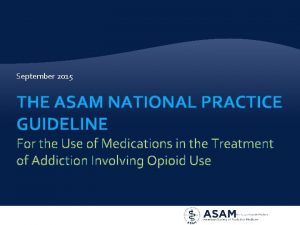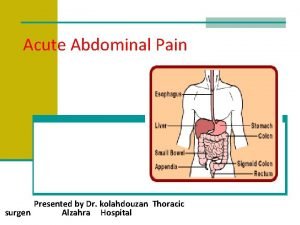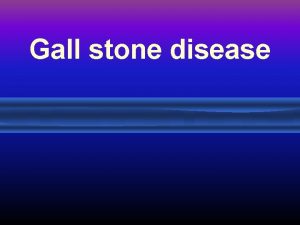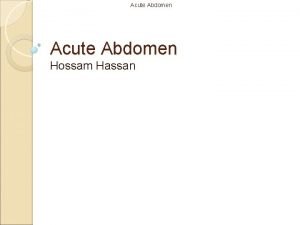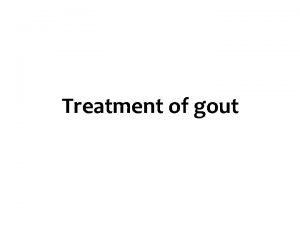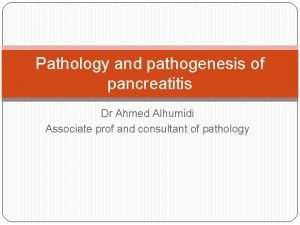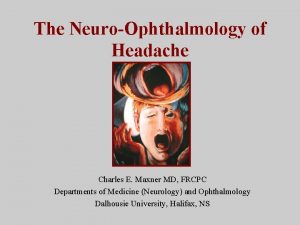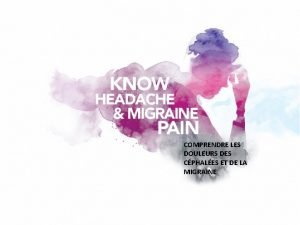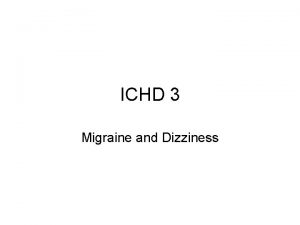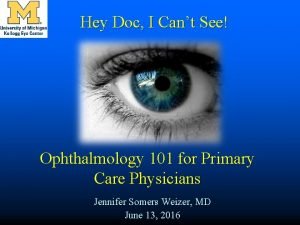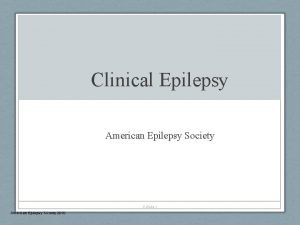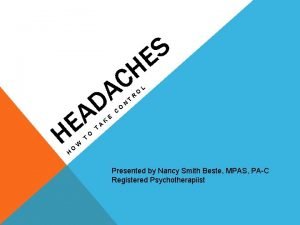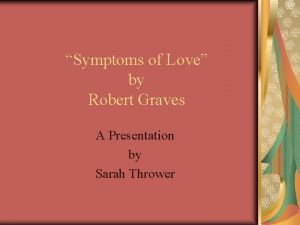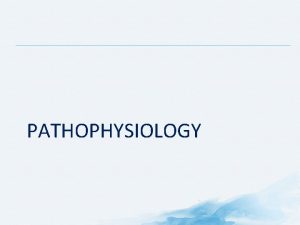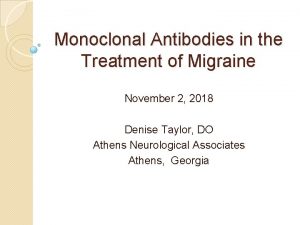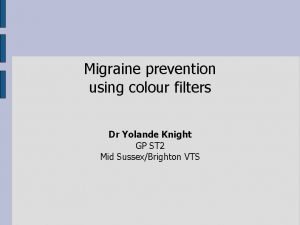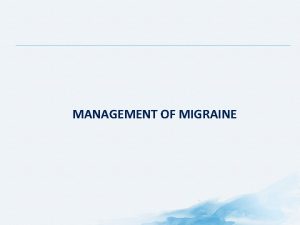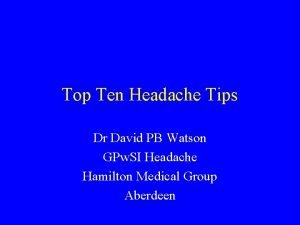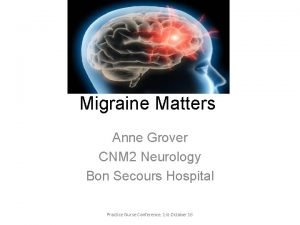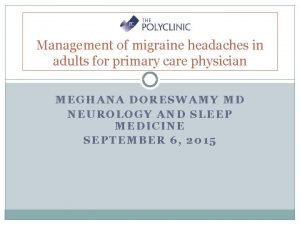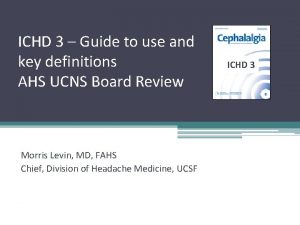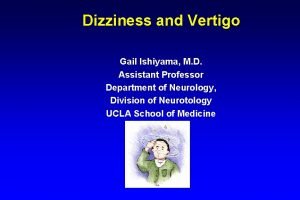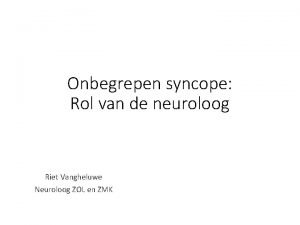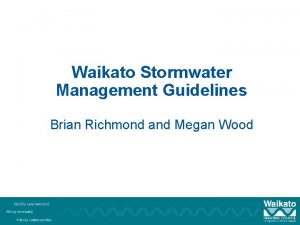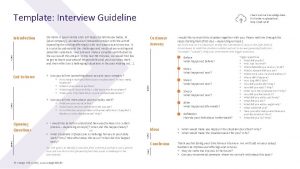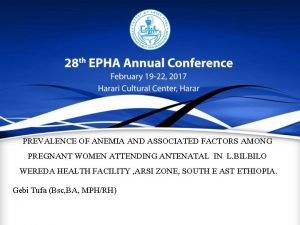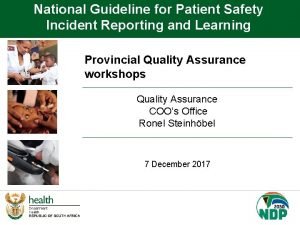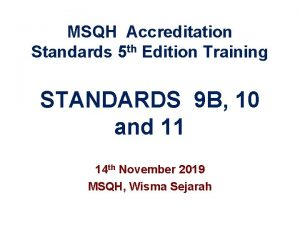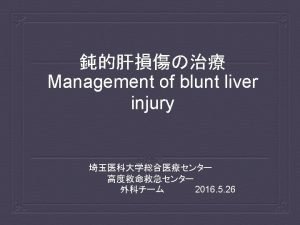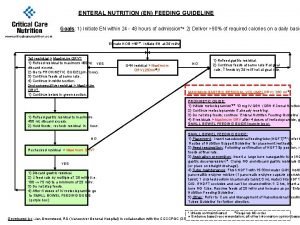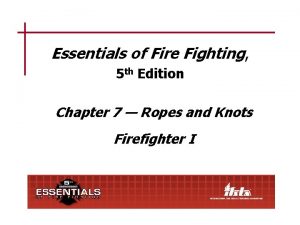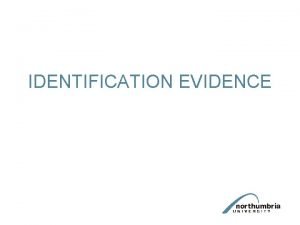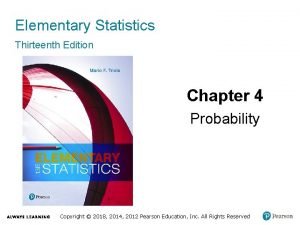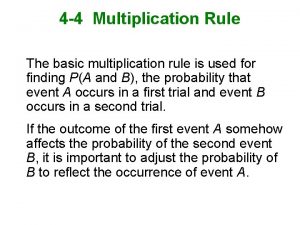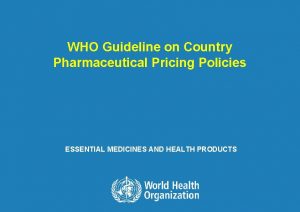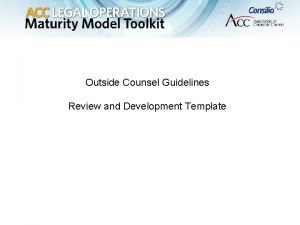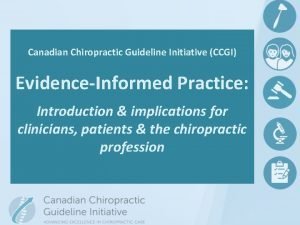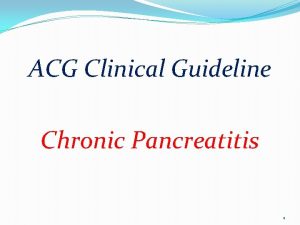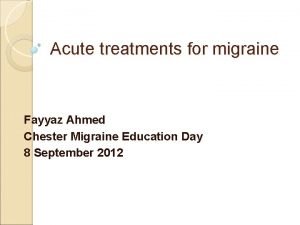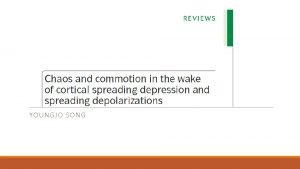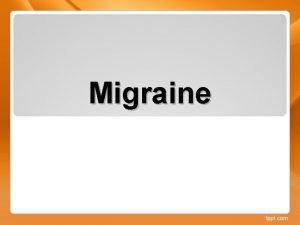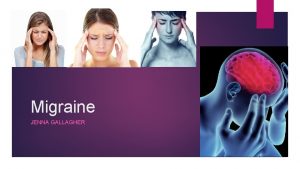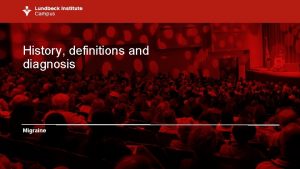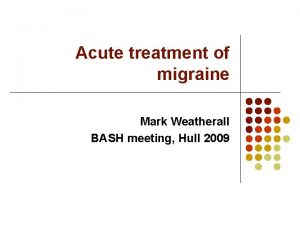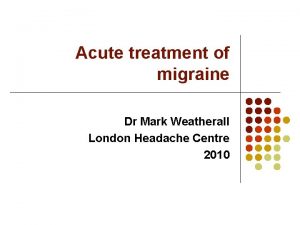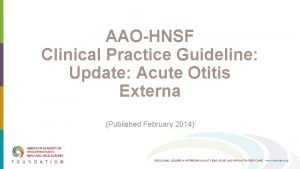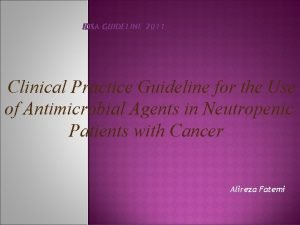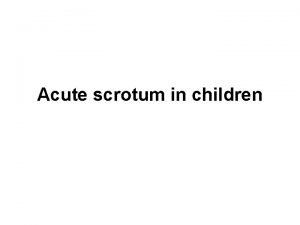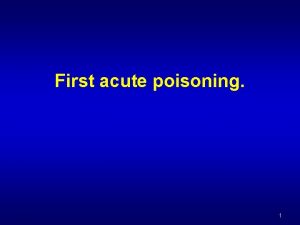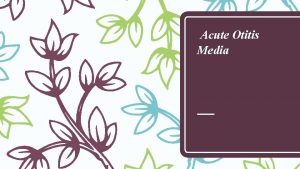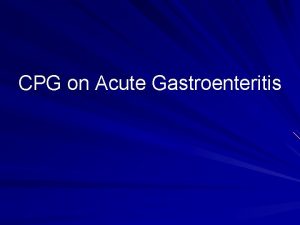Practice Guideline Update Acute Treatment of Migraine in












































- Slides: 44


Practice Guideline Update: Acute Treatment of Migraine in Children and Adolescents Report by: The Guideline Development, Dissemination, and Implementation Subcommittee of the American Academy of Neurology and The American Headache Society © 2019 American Academy of Neurology Slide 1

Practice Guideline Funding This practice guideline was developed with financial support from the American Academy of Neurology (AAN). Authors who serve or have served as AAN subcommittee members or as methodologists (M. O. , Y. H. M. , T. P. , S. P. , L. B. , D. G. , and N. L. ) were reimbursed by the AAN for expenses related to travel to subcommittee meetings where drafts of manuscripts were reviewed. All authors on the panel were reimbursed by the AAN for expenses related to travel to in-person meetings. © 2019 American Academy of Neurology Slide 2

Sharing This Information The AAN develops these presentation slides as educational tools for neurologists and other health care practitioners. You may download and retain a single copy for your personal use. Please contact guidelines@aan. com to learn about options for sharing this content beyond your personal use. © 2019 American Academy of Neurology Slide 3

Presentation Objectives • To present evidence on the efficacy of treatments for acute symptoms of migraine in children and adolescents • To present practice recommendations for the acute symptomatic treatment of children and adolescents with migraine and behavioral changes that can be made to avoid migraine events or exacerbations © 2019 American Academy of Neurology Slide 4

Overview § Introduction § Clinical questions § AAN guideline process § Methods § Conclusions § Practice recommendations © 2019 American Academy of Neurology Slide 5

Introduction • Diagnosis of primary headache disorders is based on clinical criteria specified in the International Classification of Headache Disorders, 3 rd edition (International Headache Society). 1 • Management of migraine includes acute and preventive therapies as well as behavioral and lifestyle changes. • Acute treatments must be carefully selected and individually tailored to a patient’s headache pattern, severity, and disability as well as the person’s expectations, needs, and goals of treatment. • This practice guideline systematically assess all randomized controlled trials that evaluated acute migraine treatments in children and adolescents. • This guideline updates a previous guideline published in 2004 on the treatment of migraine in children and adolescents. © 2019 American Academy of Neurology Slide 6

Clinical Questions The systematic review for this practice guideline addressed the following question: • In children and adolescents with migraine, do acute selfadministered treatments, compared with placebo, reduce headache pain and associated symptoms (nausea, vomiting, photophobia, and phonophobia) and maintain headache freedom? © 2019 American Academy of Neurology Slide 7

AAN Guideline Process* • Clinical Questions • Evidence • Conclusions • Recommendations *Guideline developed using the 2011 AAN Clinical Practice Guideline Process Manual, as amended. © 2019 American Academy of Neurology Slide 8

Literature Search/Review Rigorous, Comprehensive, Transparent 2, 482 abstracts Two databases (MEDLINE and Embase) were searched from December 1, 2003, to February 15, 2015. An updated search was conducted January 1, 2015, to August 25, 2017. Inclusion criteria: Exclusion criteria: • Fewer than 20 participants • Minimum of 90% of study participants were aged 0– 18 years • Diagnosis of migraine • Treatment was compared with placebo 16 rated articles Slide 9

A A N C l a s s i Class I A clinical RCT of the intervention of interest with masked or objective outcome assessment, in a representative population. Relevant baseline characteristics are presented and substantially equivalent between treatment groups, or there is appropriate statistical adjustment for differences. The following are also required: a. Concealed allocation b. No more than two primary outcomes specified c. Exclusion/inclusion criteria clearly defined d. Adequate accounting for dropouts (with at least 80% of enrolled subjects completing the study) and crossovers with numbers sufficiently low to have minimal potential for bias. e. For noninferiority or equivalence trials claiming to prove efficacy for one or both drugs, the following characteristics are also required*: i. The authors explicitly state the clinically meaningful difference to be excluded by defining the threshold for equivalence or noninferiority. ii. The standard treatment used in the study is substantially similar to that used in previous studies establishing efficacy of the standard treatment (e. g. , for a drug, the mode of administration, dose, and dosage adjustments are similar to those previously shown to be effective). iii. The inclusion and exclusion criteria for patient selection and the outcomes of patients on the standard treatment are comparable to those of previous studies establishing efficacy of the standard treatment. iv. The interpretation of the study results is based upon a per-protocol analysis that accounts for dropouts or crossovers. f. For crossover trials, both period and carryover effects examined and statistical adjustments performed, if appropriate. *Note that numbers I to iii in Class Ie are required for Class II in equivalence trials. If any one of the three is missing, the class is automatically downgraded to Class III. Slide 10

A A N C l a s s i Class II An RCT of the intervention of interest in a representative population with masked or objective outcome assessment that lacks one criteria a–e (see Class I) or a prospective matched cohort study with masked or objective outcome assessment in a representative population that meets items b e (see Class I). (Alternatively, a randomized crossover trial missing one of the following two characteristics: period and carryover effects described or baseline characteristics of treatment order groups presented. ) All relevant baseline characteristics are presented and substantially equivalent among treatment groups, or there is appropriate statistical adjustment for differences. Slide 11

AAN Classification of Evidence (2011) Therapeutic Scheme Class III Class IV • All other controlled trials (including studies with external controls such as well-defined natural history controls). • (Alternatively, a crossover trial missing both of the following two criteria: period and carryover effects described or baseline characteristics of treatment order groups presented. ) • A description of major confounding differences between treatment groups that could affect outcome. ** Outcome assessment is masked, objective, or performed by someone who is not a member of the treatment team. • Studies that (1) did not include patients with the disease, (2) did not include patients receiving different interventions, (3) had undefined or unaccepted interventions or outcomes measures, or (4) had no measures of effectiveness or statistical precision presented or calculable. **Objective outcome measurement: an outcome measure that is unlikely to be affected by an observer’s (patient, treating physician, investigator) expectation or bias (e. g. , blood tests, administrative outcome data). Slide 12

Clinical Question 1 In children and adolescents with migraine, do acute self-administered treatments, compared with placebo, reduce headache pain and associated symptoms (nausea, vomiting, photophobia, and phonophobia) and maintain headache freedom? Slide 13

Clinical Question: Conclusions Outcome: Pain Response at 30 Minutes Outcome Pain response at 30 minutes High confidence Moderate confidence Low confidence Very low confidence (more likely than placebo) (probably more likely than placebo) (possibly more likely than placebo) (probably no more likely than placebo) (possibly no more likely than placebo) (insufficient evidence) Sumatriptan NS 20 mg sumatriptan NS 5 mg sumatriptan OT 25 mg sumatriptan OT 50 mg Abbreviations: NS=nasal spray; OT=oral tablet Slide 14

Clinical Question: Conclusions Outcome: Pain Response at 1 Hour Outcome Pain response at 1 hour High confidence Moderate confidence Low confidence Very low confidence (more likely than placebo) (probably more likely than placebo) (possibly more likely than placebo) (probably no more likely than placebo) (possibly no more likely than placebo) (insufficient evidence) zolmitriptan NS sumatriptan 5 mg NS 5 mg sumatriptan OT 25 mg sumatriptan NS 10 mg sumatriptan OT 50 mg sumatriptan NS 20 mg Abbreviations: NS=nasal spray; OT=oral tablet Slide 15

Clinical Question: Conclusions Outcome: Pain Response at 2 Hours Outcome High confidence Moderate confidence Low confidence Very low confidence (more likely than placebo) (probably more likely than placebo) (possibly more likely than placebo) (probably no more likely than placebo) (possibly no more likely than placebo) (insufficient evidence) ibuprofen OS 7. 5 to 10 mg/kg rizatriptan ODT eletriptan OT 5 or 10 mg 40 mg Pain response at 2 hours acetaminophen OS 15 mg/kg almotriptan OT 6. 25 mg almotriptan OT 12. 5 mg sumatriptan NS 20 mg almotriptan OT 25 mg sumatriptan NS 10 mg sumatriptan OT 25 mg sumatriptan OT 50 mg zolmitriptan NS 5 mg Abbreviations: NS=nasal spray; ODT=oral disintegrating tablet; OS=oral solution; OT=oral tablet Slide 16

Clinical Question: Conclusions Outcome: Pain Free at 1 Hour Outcome Pain free at 1 hour High confidence Moderate confidence Low confidence Very low confidence (more likely than placebo) (probably more likely than placebo) (possibly more likely than placebo) (probably no more likely than placebo) (possibly no more likely than placebo) (insufficient evidence) zolmitriptan NS 5 mg Abbreviations: NS=nasal spray Slide 17

Clinical Question: Conclusions Outcome: Pain Free at 2 Hours Outcome Pain free at 2 hours High confidence Moderate confidence Low Very low confidence (more likely than placebo) (probably more likely than placebo) (possibly more likely than placebo) (probably no more likely than placebo) (possibly no more likely than placebo) (insufficient evidence) sumatriptan naproxen OT 10/60 mg ibuprofen OS 7. 5 to 10 mg/kg rizatriptan ODT 5 or 10 mg almotriptan OT 12. 5 mg acetaminophen OS 15 mg/kg sumatriptan/na proxen OT 30/180 mg sumatriptan NS 20 mg sumatriptan/na proxen OT 85/500 mg zolmitriptan NS 5 mg almotriptan OT 6. 25 mg almotriptan OT 25 mg eletriptan OT 40 mg sumatriptan OT 25 mg sumatriptan OT 50 mg Abbreviations: NS=nasal spray; ODT=oral disintegrating tablet; OS=oral solution; OT=oral tablet Slide 18

Clinical Question: Conclusions Outcome: Relief of Nausea at 2 Hours Outcome Relief of nausea at 2 hours High confidence Moderate confidence Low confidence Very low confidence (more likely than placebo) (probably more likely than placebo) (possibly more likely than placebo) (probably no more likely than placebo) (possibly no more likely than placebo) (insufficient evidence) sumatriptan NS 5 mg eletriptan OT 40 mg ibuprofen OS 7. 5 to 10 mg/kg sumatriptan NS 20 mg sumatriptan/na proxen OT 85/500 mg sumatriptan NS 10 mg sumatriptan/na proxen OT 10/60 mg sumatriptan/na proxen OT 30/180 mg rizatriptan ODT 5 or 10 mg Abbreviations: NS=nasal spray; ODT=oral disintegrating tablet; OS=oral solution; OT=oral tablet Slide 19

Clinical Question: Conclusions Outcome: Relief of Vomiting at 2 Hours Outcome Relief of vomiting at 2 hours High confidence Moderate confidence Low confidence Very low confidence (more likely than placebo) (probably more likely than placebo) (possibly more likely than placebo) (probably no more likely than placebo) (possibly no more likely than placebo) (insufficient evidence) sumatriptan NS 5 mg sumatriptan NS 10 mg sumatriptan NS 20 mg rizatriptan ODT 5 or 10 mg Abbreviations: NS=nasal spray; ODT=oral disintegrating tablet Slide 20

Clinical Question: Conclusions Outcome: Relief of Photophobia Outcome High confidence Moderate confidence Low confidence Very low confidence (more likely than placebo) (probably more likely than placebo) (possibly more likely than placebo) (probably no more likely than placebo) (possibly no more likely than placebo) (insufficient evidence) Relief of photophobia at 30 minutes zolmitriptan NS 5 mg Relief of photophobia at 2 hours sumatriptan/na proxen OT 10/60 mg zolmitriptan NS 5 mg eletriptan OT 40 mg sumatriptan NS 10 mg sumatriptan/na proxen OT 85/500 mg sumatriptan/na proxen OT 30/180 mg rizatriptan ODT 5 or 10 mg Abbreviations: NS=nasal spray; ODT=oral disintegrating tablet; OT=oral tablet Slide 21

Clinical Question: Conclusions Outcome: Relief of Phonophobia at 30 Minutes Outcome High confidence Moderate confidence Low confidence Very low confidence (more likely than placebo) (probably more likely than placebo) (possibly more likely than placebo) (probably no more likely than placebo) (possibly no more likely than placebo) (insufficient evidence) Relief of phonophobia at 30 minutes zolmitriptan NS 5 mg Relief of phonophobia at 2 hours sumatriptan/na proxen OT 10/60 mg sumatriptan NS 5 mg rizatriptan ODT eletriptan OT 5 or 10 mg 40 mg sumatriptan/na proxen OT 85/500 mg sumatriptan NS 20 mg sumatriptan NS 10 mg zolmitriptan NS 5 mg sumatriptan/na proxen OT 30/180 mg Slide 22

Practice Recommendations Establish a Specific Headache Diagnosis Recommendation 1: Rationale The appropriate care of a patient with headaches requires establishing a correct diagnosis. This affects our diagnostic approach, treatment, and prognosis. Patients with signs and symptoms of secondary headache, such as sudden change in headache, papilledema, focal deficits, and the additional presence of seizures, require further evaluation beyond a thorough history and physical examination. When migraine is diagnosed, tailored treatments may be considered that can result in improved outcomes. 19 Diagnostic criteria for pediatric migraine include at least 5 headaches over the past year that last 2− 72 hours when untreated, with 2 of 4 additional features (pulsatile quality, unilateral, worsening with activity or limiting activity, moderate to severe in intensity), and association with at least nausea, vomiting, photophobia, or phonophobia. These associated symptoms can be inferred by family report of the child’s activities. The time a child sleeps can be considered part of the headache duration. Auras typically occur in about one third of older children and adolescents and precede the headache by 5− 60 minutes. 1 Slide 23

Practice Recommendations Recommendation Statements 1 a and 1 b: • Recommendation 1 a: When evaluating children and adolescents with headache, clinicians should diagnose a specific headache type (primary, secondary, or other headache syndrome) (Level B). • Recommendation 1 b: When evaluating children and adolescents with headache, clinicians should ask about premonitory and aura symptoms, headache semiology (onset, location, quality, severity, frequency, duration, aggravating and alleviating factors), associated symptoms (nausea, vomiting, phonophobia, and photophobia), and pain-related disability in order to improve diagnostic accuracy for migraine and appropriately counsel the patient (Level B). Slide 24

Practice Recommendations Acute Migraine Treatment Recommendation 2: Rationale Migraine treatment should aim to achieve fast, complete pain relief, with minimum side effects. Associated symptoms like nausea, vomiting, photophobia, and phonophobia should also be addressed. In adults, early treatment of migraine (within less than 1 hour of headache onset) improves pain-free rates. 20 Improved efficacy with early treatment is likely to be seen in children and adolescents as well. Many children and adolescents use and benefit from nonprescription oral analgesics like acetaminophen, ibuprofen, and naproxen. 21 Triptans are less commonly prescribed in children than in adults, and only almotriptan (for patients aged 12 years and older), rizatriptan (for patients aged 6– 17 years), sumatriptan/naproxen (for patients aged 12 years and older), and zolmitriptan NS (for patients aged 12 years and older) are approved by the Food and Drug Administration (FDA) for use in children. Ergots and oral naproxen alone have not been studied in children. Slide 25

Practice Recommendations Recommendation Statements 2 a− 2 c: • Recommendation 2 a: Clinicians should counsel that acute migraine treatments are more likely to be effective when used earlier in the migraine attack, when pain is still mild (Level B). • Recommendation 2 b: Clinicians should prescribe ibuprofen OS (10 mg/kg) as an initial treatment option to reduce pain in children and adolescents with migraine (Level B). • Recommendation 2 c: For adolescents with migraine, clinicians should prescribe sumatriptan/naproxen OT (10/60 mg, 30/180 mg, 85/500 mg), zolmitriptan NS (5 mg), sumatriptan NS (20 mg), rizatriptan ODT (5 mg or 10 mg), or almotriptan OT (6. 25 mg or 12. 5 mg) to reduce headache pain (Level B). Slide 26

Practice Recommendations Acute Migraine Treatment Recommendation 3: Rationale Patients respond differently to the same medication. In adults, failure to respond to one triptan does not preclude response to an alternate triptan. 22 In adults, a second dose of triptan at 2 hours does not increase initial efficacy or prevent or delay headache recurrence but is effective in treating migraine recurrence. 23 Children might have the same experience, but product monograph daily maximum doses must be followed. Migraine features (severity, associated symptoms, disability, and most bothersome symptoms) differ among individuals and among different attacks in the same individual. 24 Intranasal sumatriptan and zolmitriptan are absorbed more quickly than the oral form 25, 26 and have a faster onset of action. 27, 28 For migraines that rapidly peak in severity or are associated with nausea and vomiting, nonoral forms of treatment may be more effective. Thus, children with migraine may benefit from more than one acute treatment choice and different delivery routes, depending on their individual headache characteristics. Slide 27

Practice Recommendations Recommendation Statements 3 a− 3 e: • Recommendation 3 a: Clinicians should counsel patients and families that a series of medications may need to be used to find treatments that most benefit the patient (Level B). • Recommendation 3 b: Clinicians should instruct patients and families to use the medication that best treats the characteristics of each migraine to provide the best balance of efficacy, side effects, and patient preference (Level B). • Recommendation 3 c: Clinicians should offer an alternate triptan, if one triptan fails to provide pain relief, to find the most effective agent to reduce migraine symptoms (Level B). • Recommendation 3 d: Clinicians may prescribe a nonoral route when headache peaks in severity quickly, is accompanied by nausea and/or vomiting, or oral formulations fail to provide pain relief (Level C). • Recommendation 3 e: Clinicians should counsel patients and families that a second dose of an acute migraine medication after 2 hours can treat Slide 28 headache recurrence (Level B).

Practice Recommendations Acute Migraine Treatment Recommendation 4: Rationale Sumatriptan/naproxen OT (10/60 mg, 30/180 mg, and 85/500 mg) is more likely than placebo to result in headache pain-free status at 2 hours. Sumatriptan and naproxen have a different pharmacokinetic profiles targeted to aid in migraine relief. 29 In adults, the sumatriptan/naproxen combination OT is more effective than monotherapy with either component. 30 Because of cost and insurance issues, not all patients have access to all available formulations of medications. Given the distinct mechanisms of action among medications in the triptan class and the nonsteroidal antiinflammatory drug (NSAID) class, the addition of an NSAID to a triptan may improve rates of pain response and pain-free status. Slide 29

Practice Recommendations Recommendation Statement 4: • Recommendation 4: In adolescents whose migraine is incompletely responsive to a triptan, clinicians should offer ibuprofen or naproxen in addition to a triptan to improve migraine relief (Level B). Slide 30

Practice Recommendations Treatment of Associated Symptoms Recommendation 5: Rationale Migraine is typically accompanied by other symptoms (nausea, vomiting, photophobia, phonophobia) in addition to head pain. Antiemetics are often prescribed along with specific (triptan) and nonspecific (NSAID) migraine treatments to address nausea and vomiting and to speed the rate of medication absorption. In pediatric migraine trials, the treatment effects on migraine-associated symptoms were less pronounced than the treatment effects on pain. While photophobia and phonophobia were responsive to zolmitriptan nasal spray and sumatriptan/naproxen, none of the treatments studied had demonstrated effectiveness against nausea or vomiting. Antiemetics are available to treat nausea and vomiting related to other pediatric conditions (acute gastroenteritis, postoperative state, chemotherapy)31, 32 and may be of benefit for migraine-associated nausea, although no clinical trials specifically evaluating antiemetics for pediatric migraine-associated nausea have been performed. Nasal spray formulations of zolmitriptan and sumatriptan may be easier to administer in adolescents Slide 31 with migraine with prominent nausea and/or vomiting.

Practice Recommendations Recommendation Statement 5: • Recommendation 5: For children and adolescents with migraine who experience prominent nausea and/or vomiting, clinicians should offer additional antiemetic treatments (Level B). Slide 32

Practice Recommendations Counseling Recommendation 6: Rationale Patient education can improve patient safety and adherence to interventions. It is important to learn about the behavioral aspects of selfcare that might improve migraine, including healthy habits with lifestyle modification, potential migraine triggers/aggravating factors, and the risk of overusing medication. Maintaining a headache diary is helpful to track response to any new therapy. Patients and families will benefit from understanding the limitations of current available treatments. Overuse of medication to treat acute attacks has been associated with medication overuse headache in adults 33 but has not been well studied in children. Methods to prevent medication overuse headache are included in adult treatment plans. Slide 33

Practice Recommendations Recommendation Statements 6 a− 6 d: • Recommendation 6 a: Clinicians should counsel children and adolescents with migraine and their families about migraine-healthy habits, including lifestyle modification, identification/disproof/resolution of migraine triggers/aggravating factors, and avoidance of medication overuse (Level B). • Recommendation 6 b: Clinicians should make collaborative agreements with children and adolescents with migraine and their families on treatment goals that are individualized to the patient (Level B). • Recommendation 6 c: Clinicians may counsel children and adolescents with migraine and their families to maintain a headache diary to monitor their response to treatments (Level C). • Recommendation 6 d: Clinicians should counsel patients and families to use no more than 14 days of ibuprofen or acetaminophen per month, no more than 9 days of triptans per month, and no more than 9 days per month of any combination of triptans, analgesics, or opioids for more than 3 months to avoid medication overuse headache (Level B). (There is no evidence to support the use of opioids in children with migraine. Opioids are included Slide 34 in this statement to be consistent with the International Classification of Headache Disorders 1 regarding medication overuse. )

Practice Recommendations Contraindications and Precautions to Triptan Use Recommendation 7: Rationale According to the FDA, triptans are contraindicated in patients with a history of cardiovascular disease, including stroke, transient ischemic attacks, myocardial infarction, severe peripheral vascular disease, ischemic bowel disease, and coronary vasospasm, including Prinzmetal angina. Triptans are also contraindicated in patients with cardiac accessory conduction pathway disorders, including Wolff-Parkinson-White syndrome. Although the 2004 American Headache Society consensus statement does not consider these as absolute contraindications, 34 these contraindications are based on the known pharmacology of the triptans 35 and triptan effects on vascular muscle. 36 While these medical contraindications are less prevalent in the pediatric population, they are important to consider. . Slide 35

Practice Recommendations Recommendation Statement 7: • Recommendation 7: Clinicians must not prescribe triptans to those with a history of ischemic vascular disease or accessory conduction pathway disorders to avoid the morbidity and mortality associated with aggravating these conditions (Level A). Slide 36

Practice Recommendations Contraindications and Precautions to Triptan Use Recommendation 8: Rationale In adults who have migraine with typical aura, there is evidence that it is safe to take triptans during the aura, although the triptan may be more effective if taken at the onset of pain. 37, 38 The use of triptans during the aura phase is of concern because of potential difficulties differentiating early stroke symptoms from migraine aura. While this is unlikely a problem in those with established migraine with visual aura, caution is warranted in those with more complex aura presentations. According to the FDA, triptans are contraindicated in those with a history of hemiplegic aura or migraine with brainstem aura. This contraindication was based on a view of migraine pathophysiology that is no longer considered current. Slide 37

Practice Recommendations Recommendation Statements 8 a and 8 b: • Recommendation 8 a: Clinicians should counsel adolescent patients with migraine with aura that taking their triptan during a typical aura is safe, but that the triptan may be more effective if taken at the onset of head pain (Level B). • Recommendation 8 b: Clinicians may consider referral of children and adolescents with hemiplegic or basilar type auras who do not respond to other treatments to a headache specialist to find effective treatment (Level C). Slide 38

Suggestions for Future Research • Most adults with migraine have onset in childhood or adolescence. Accurate diagnosis and treatment in childhood and adolescence can prevent migraine-related disability and significantly improve quality of life. 19 • Lifestyle modifications and acute pharmacologic treatments are the mainstay of management. Although the pathophysiology of migraine is presumed to be the same as in adults, a higher placebo response is observed in children and adolescents, with a lower therapeutic gain measured in clinical trials. 39 • Patterns of migraine presentation and associated symptoms in children and adolescents evolve into the adult patterns and their shortest headaches may be shorter in duration. 1 These factors should be considered when designing clinical trials. • The fact that all acute treatment trials in children and adolescents are performed after proven efficacy in adults may be a contributor to the expectation response adding to the placebo effect. This expectation response is widely seen in pain studies and may explain why so few trials of acute migraine therapy in children and adolescents have shown positive results. Slide 39

Suggestions for Future Research (continued) • Although there is a growing body of evidence to support recommendations for the acute treatment of pediatric migraine, challenges remain. • Many children and adolescents do not respond to treatment at home with NSAIDs and triptans and seek pain relief at an emergency department or infusion center. 40 • Trials of refractory headache treatment in children and adolescents have been conducted 41 but therapeutic approaches in these circumstances vary. 42 • Studies are also needed of alternate delivery routes for acute treatments such as transdermal patches because oral medications are poorly absorbed in children and adolescents with nausea and vomiting. • Regardless of the strategy chosen for acute migraine therapy, treatment plans should be individually tailored to the patient and family and include education about migraine prevention strategies. Slide 40

References cited here can be found in the guideline summary article. To locate this material, please visit AAN. com/guidelines. Slide 41

Access Guideline and Summary Tools • To access the complete guideline and related summary tools, visit AAN. com/guidelines. • Summary guideline article • Full-length guideline article • Summary for clinicians • Summary for patients/families Slide 42

Questions? © 2019 American Academy of Neurology
 Which is an alternative of log based recovery
Which is an alternative of log based recovery Asam national practice guideline
Asam national practice guideline Kdigo 2012 aki
Kdigo 2012 aki Dr friedman cushing's
Dr friedman cushing's Causes of acute abdominal pain
Causes of acute abdominal pain Gallstone anatomy
Gallstone anatomy Acute abdomen causes
Acute abdomen causes Is gout like arthritis
Is gout like arthritis Acute pancreatitis pathophysiology
Acute pancreatitis pathophysiology Headache chart
Headache chart Migraine avec aura définition
Migraine avec aura définition Ichd 3 vestibular migraine
Ichd 3 vestibular migraine Ocular migraine
Ocular migraine Migraine aura vs seizure aura
Migraine aura vs seizure aura Migraine triggers
Migraine triggers Symptoms of love
Symptoms of love Trigeminal migraine
Trigeminal migraine Trigeminal migraine
Trigeminal migraine Emgality storage
Emgality storage Migraine
Migraine Migraine management guidelines
Migraine management guidelines Postdrome symptoms
Postdrome symptoms Migraine postdrome symptoms
Migraine postdrome symptoms Pathophysiology of migraine
Pathophysiology of migraine Retinal migraine
Retinal migraine Vestibular migraine
Vestibular migraine Prodromen epilepsie
Prodromen epilepsie Waikato stormwater management guideline
Waikato stormwater management guideline Interview guideline template
Interview guideline template Anemia in pregnancy guideline
Anemia in pregnancy guideline Autoanamnesa
Autoanamnesa Patient safety incident definition
Patient safety incident definition Msqh standard
Msqh standard Anamnesa psikologi
Anamnesa psikologi East guideline
East guideline En feeding guide
En feeding guide Pivoting section in haircutting
Pivoting section in haircutting What is a guideline for hoisting a hoseline?
What is a guideline for hoisting a hoseline? R v turnbull
R v turnbull Elementary statistics chapter 4
Elementary statistics chapter 4 Formal multiplication rule
Formal multiplication rule Who guideline on country pharmaceutical pricing policies
Who guideline on country pharmaceutical pricing policies Outside counsel guidelines template
Outside counsel guidelines template Canadian chiropractic guideline initiative
Canadian chiropractic guideline initiative Acg chronic pancreatitis
Acg chronic pancreatitis

